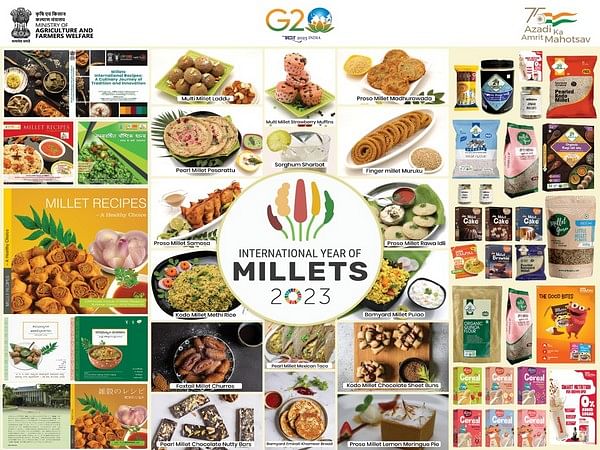New Delhi [India], February 26 (ANI): In a move to harness the export potential of millets to the Gulf Cooperation Council (GCCs) countries, the Agricultural and Processed Food Products Export Development Authority (APEDA) that works under the Ministry of Commerce signed a Memorandum of Understanding (MoU) with Lulu Hypermarket recently.
To be precise, the agreement was signed on February 21, 2023.
APEDA aims to promote millet products and value-added products around the world in association with Lulu Group, which is an international retail hypermarket chain that operates stores and shopping malls across Bahrain, Kuwait, Oman, Qatar, Saudi Arabia, and the United Arab Emirates, Egypt, India and the Far East.
As per the agreement, the Lulu Group will facilitate promotional activities for millet products and enable the country to display millets and its value-added products, ready to eat products in international retail chains by sourcing it from Farmer Producer Organizations, Farmer Producer Companies, women entrepreneurs and startups.
“As per the agreement, the Lulu Group will facilitate promotional activities for millet products and enable the country to display millets and its value-added products, ready to eat products in international retail chains by sourcing it from Farmer Producer Organizations, Farmer Producer Companies, women entrepreneurs and startups,” an official release said.
The government of India under Prime Minister Narendra Modi spearheaded the United Nations General Assembly (UNGA) resolution for declaring the year 2023 as the International Year of Millets and the proposal of India was supported by 72 countries. UNGA declared 2023 as the International Year of Millets back in March 2021.
The International Year of Millets 2023 officially kicked off on January 1, 2023.
As a part of its series of events for the promotion of the International Year of Millets (IYoM) 2023, APEDA is organizing export promotion activities for millets in 16 International Trade Fairs, including Gulfood 2023.
As per official data, India registered a growth of 8.02% in the export of millets in the financial year 2021-22 as the export of millets was 159,332.16 metric tonne against 147,501.08 metric tonne during the same period last year.
India is a global leader in the production of millets with an area of about 12.5 million hectares and a share of more than 15 per cent of the world’s total production. Rajasthan, Uttar Pradesh, Haryana, Gujarat, Madhya Pradesh, Maharashtra, Karnataka, Tamil Nadu, Andhra Pradesh, and Telangana are the major millets producing states.
Indian Council of Agricultural Research (ICAR), through its Indian Institute of Millets Research (IIMR), has so far succeeded in developing many bio-fortified varieties and novel products for the benefit of farmers and society at large.
What are millets?
Millet is a common term for categorizing small-seeded grasses that are often called Nutri-cereals. Some of them are sorghum (jowar), pearl millet (bajra), finger millet (ragi), little millet (kutki), foxtail millet (kakun), proso millet (cheena), barnyard millet (sawa), and kodo millet (kodon).
Millets are now being promoted as ‘Super food’.
Significance and benefits of millets:
Millets are nutritionally superior to wheat and rice owing to their higher protein levels and a more balanced amino acid profile. Millets also contain various phytochemicals which exert therapeutic properties owing to their anti-inflammatory and anti-oxidative properties.
Further, besides being climate resilient, millet grains are rich sources of nutrients like carbohydrates, protein, dietary fibre, and good-quality fat; minerals like calcium, potassium, magnesium, iron, manganese, zinc and B complex vitamins.
Most importantly, millet production is not dependent on the use of chemical fertilizers.
Background of millets in India:
Millets were traditionally consumed, but due to the push given to food security through Green Revolution in the 1960s, millets were less consumed and almost forgotten.
Before the Green Revolution, millets made up around 40 per cent of all cultivated grains, which has dropped to around 20 per cent over the years. (ANI)
This report is auto-generated from ANI news service. ThePrint holds no responsibility for its content.



